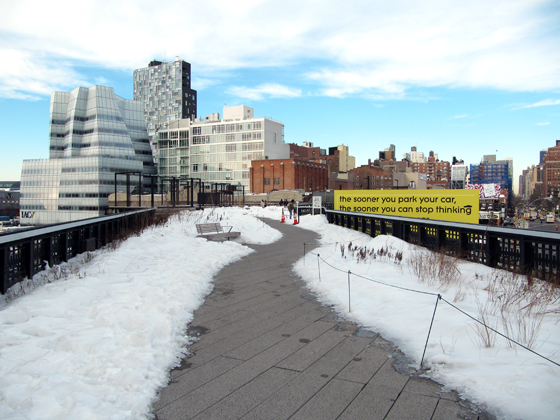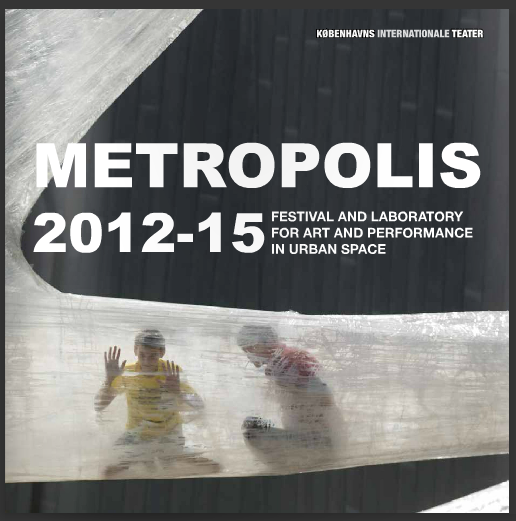 During the early 2011, Urban Dream Management has been busy exploring and writing less. In February, I had the chance to spend a month flâneuring the streets of New York, where spring was making its first attempts to beat the cold weather.
During the early 2011, Urban Dream Management has been busy exploring and writing less. In February, I had the chance to spend a month flâneuring the streets of New York, where spring was making its first attempts to beat the cold weather.
Among the first things on my list in New York, was a long-anticipated visit to the High Line, a public park built on an abandoned elevated railroad stretching from the Meatpacking District to the Hudson Rail Yards in Manhattan. I saw the park in its quiet, snow-covered winter mood and returned there on a sunny afternoon at the end of the month, when it was packed with people spending their weekend. The park design features an integrated landscape, designed by Diller Scofidio + Renfro with Field Operations. It combines meandering concrete pathways with naturalistic plantings that draws its inspiration from the beauty of the original biodiversity that took over after the railroad fell into a ruin.


Even in its winter appearance with most of the vegetation only dry, brown hay, the melancholic beauty of the place was astonishing. The special atmosphere is a result of, not only the delicate design and the postindustrial ruin, but even more, the constantly changing views to the layered cityscape of New York, the Hudson river and the surrounding districts. During my second visit, the park was full of people, wandering their ways above the noise of busy Manhattan streets, and enjoying the sun on the park benches.


The first section of this elevated parkway, running from Gansevoort Street to West 20 Street, was opened for public in 2009, and the second section will be accessible later this year, opening up even more of the fantastic views up until 30th Streets. The future of the final one-third of the park still hinges on the plans for the redevelopment of the area. When all sections are complete, the High Line will be a 2,4 km long elevated park, running through the West Side neighborhoods of the Meatpacking District, West Chelsea and Clinton/Hell’s Kitchen.
The history of this elevated railroad is full of interesting details. It was originally constructed in the 1930s, to lift dangerous freight trains off Manhattan’s streets. Serving the busy industrial waterfront, the West Side freight corridor had been known as “Death Avenue” due to many traffic accidents. The new elevated line connected directly to factories and warehouses, allowing all trains to roll through buildings and deliver milk, meat, produce and other goods to upper-story loading docks.
During the 1960s, industrial use began to decline on Manhattan’s West Side, and the last freight trains rolled down the High Line in the 1980s. The tracks were left unused, and gradually, wild nature reclaimed a once vital piece of urban infrastructure.


The fact that people can now enjoy the High Line as a park area, is possible thanks to the non-profit group “Friends of the High Line”, which was formed by the neighborhood residents at the turn of the millennium. The railway was converted into a public park with the support of New York City Council, and the non-profit group is now responsible for overseeing and funding the line’s ongoing maintenance and operations.
The website www.thehighline.org offers a great variety of breathtaking photos from the High Line before and after the park construction. A visit to the historical photo section is warmly recommended.


Now back in Helsinki, it is interesting to rethink the debate the High Line recently raised after an article published by Helsingin Sanomat. As the industrial landscape in central Helsinki is now at a major turning point after the two main harbors were moved to the north, we have two large harbor areas and a central freight railway freed for new uses. Helsinki’s central railway tunnel has been referred to as our “Low Line”, as it also possesses the potential to be turned into an intriguing public space. In fact, after years of planning, a new pedestrian and bicycle connection, “Baana“, will be opened there later this year, running through the tunnel. Even if it’s great that the tunnel will be opened for public use, the potential outcome looks rather dry. There doesn’t seem to be enough courage within our city to utilise the full potential of this unique place. Maybe there is still hope that Helsinki’s next year as World Design capital would bring about the courage to put effort in realising new, unique public spaces that would serve more than merely practical needs. The High Line clearly offers an inspiring reference for us.
____________________________________________________________________________________
Brief Notes from New York
This series presents moments and observations from the city of all cities: New York. The series was started by Kati Laakso, who is originally from Helsinki, Finland, and has been living in New York for two years. During the spring 2011, she is joined by Hella Hernberg, who recently spent a month as artist-in-residence in Manhattan.
New York as a city and a cultural landscape is in constant change. The evolving nature of its structure and inhabitants transforms it from day to day, year to year. The change does not only occur in the city structure but also in the social forms taking place in different places every minute. Not only the city itself but also its inhabitants are constantly developing new forms of life, new forms of doing things, and making the city what it has been and will be tomorrow.
____________________________________________________________________________________







